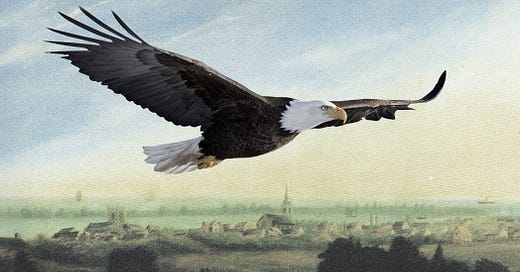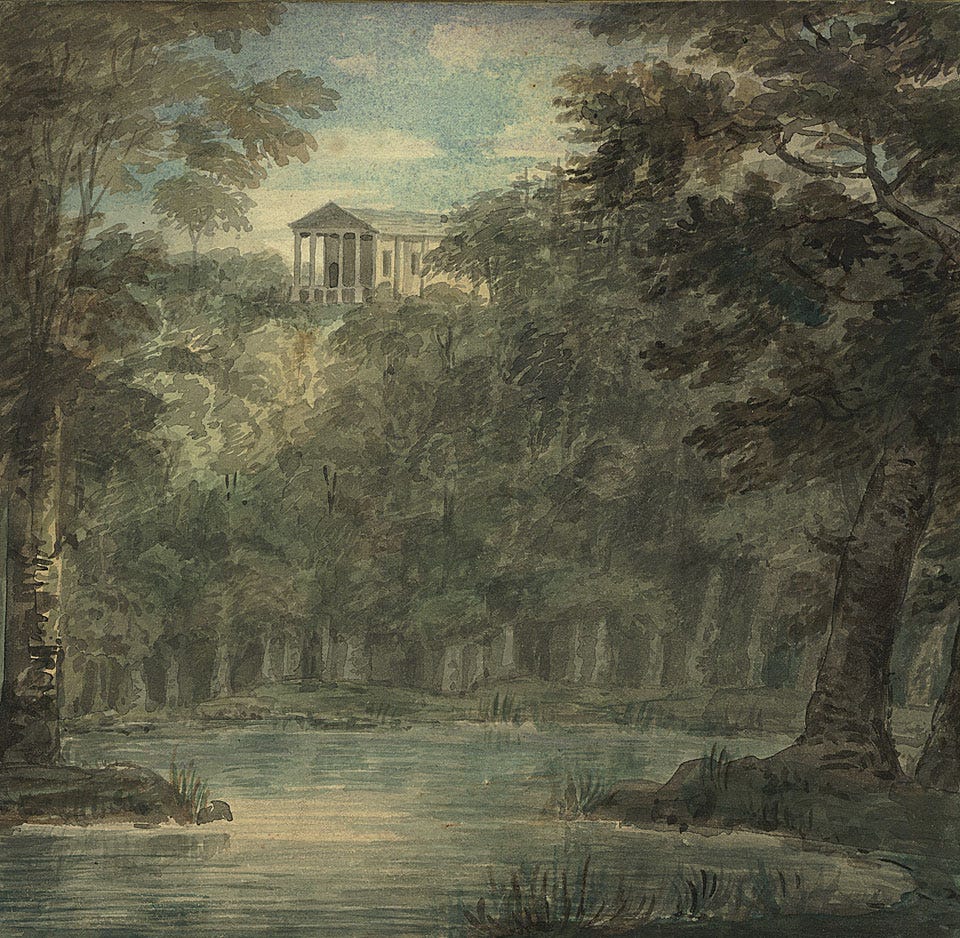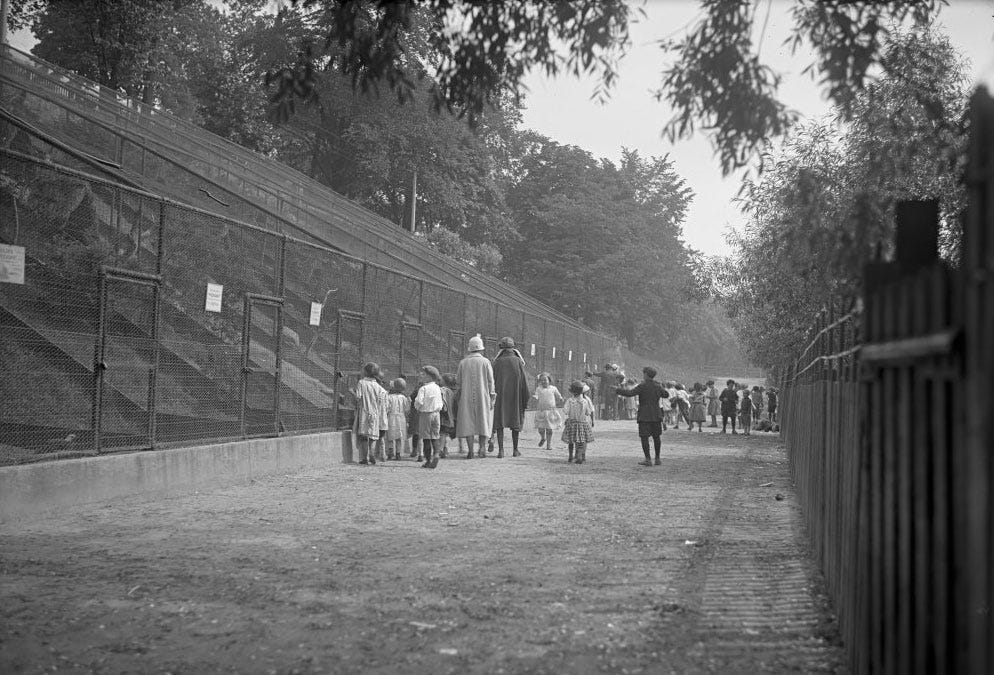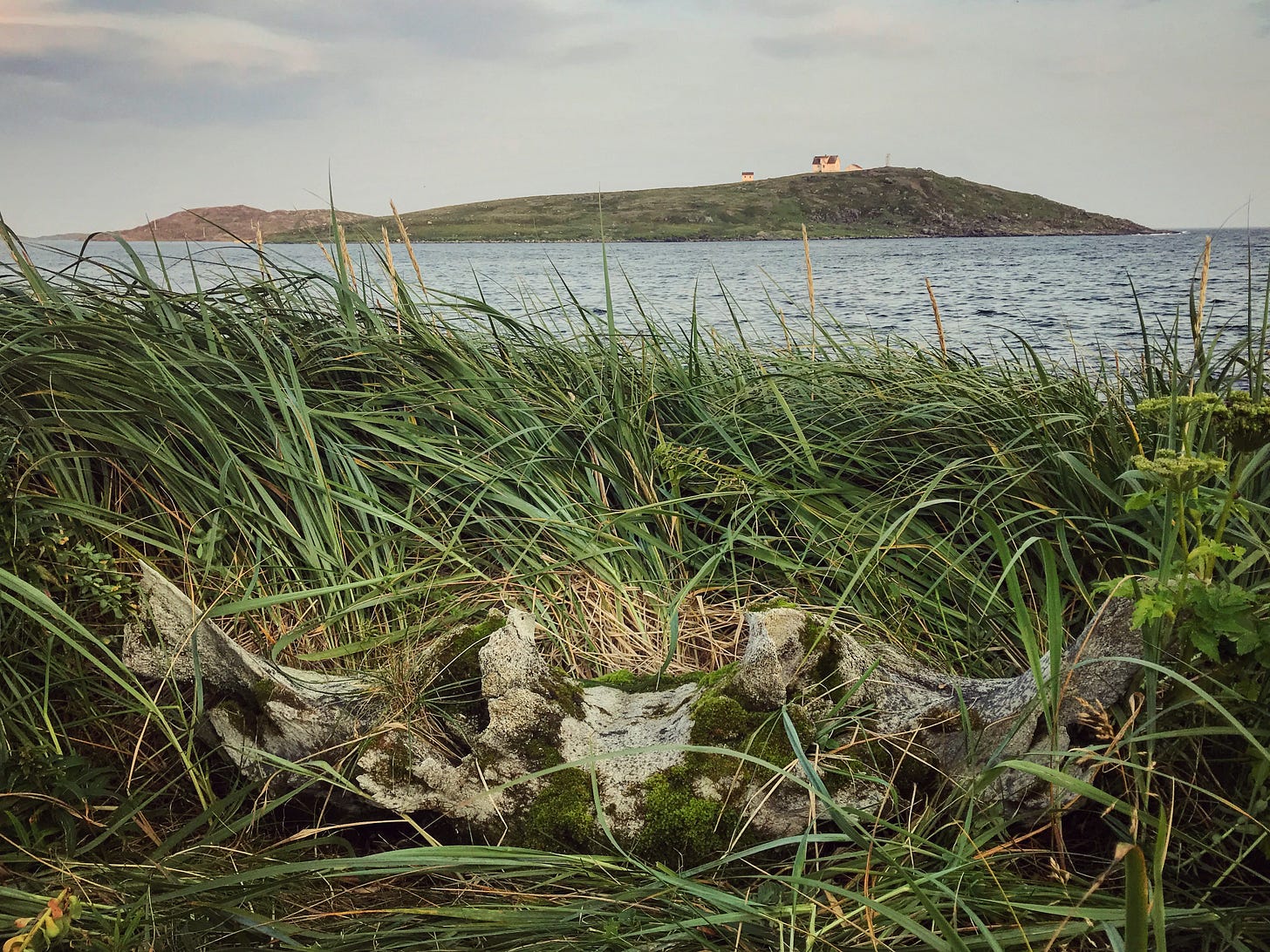A Brief History of Bald Eagles in Toronto
Plus one of the city's most scandalous families, a strange heist and more...
It was a September day in 1793. A small boat was making its way up the Don River. The winding waterway snaked along the wide valley floor, dwarfed by the towering slopes above it, surrounded by meadows and thriving forests of butternut, oak and pine. Those woods were filled with deer, wolves and bears, even cougars. Every fall, the river flowed thick with salmon and vast flocks of passenger pigeons darkened the sky on their annual migration.
By then, this land had already been home to First Nations and their ancestors for thousands and thousands of years — the Wendat, the Haudenosaunee, the Mississaugas. The forests had been carefully maintained. Fields planted. Villages built. But the people in that small boat were new arrivals: British settlers who'd come to build a colonial capital on the shores of Lake Ontario. Lieutenant-Governor John Graves Simcoe was one of those on board. So was his wife, Elizabeth.
They'd been living here for a little over a month at that point, pitching a fancy tent on the lakeshore next to a creek they called the Garrison. Soldiers had already begun chopping down trees to make way for Fort York and for the new town. On that particular September day, the Simcoes had left the waterfront, rowing up the river to visit a nearby farm; it was run by one of the first settlers to live in the Don Valley, just north of where the Bloor Street Viaduct is today.
"We found the river very shallow in many parts and obstructed by fallen trees," Elizabeth Simcoe wrote in her diary. "One of them lay so high above the water that the boat passed under, the rowers stooping their heads. It looked picturesque..."
That's when she saw it. It was perched on the barren branches of a blasted pine standing high above them — on a bold point overlooking the valley. A majestic bird was keeping watch over the river: One of the bald eagles of Toronto.
Bald eagles were living here lonnng before our city was founded. The species is thought to have evolved about a million years ago, and they've been soaring through the skies above North America ever since. For many First Nations, the eagles have had powerful spiritual and symbolic meaning for countless centuries. "It's a very sacred bird to us," Duke Redbird, an Ojibway elder, recently explained to the CBC. "It represents so many good things: honour, honesty, charity, life…" The flag of the Mississaugas of the Credit First Nation has a bald eagle at its very centre.
It's easy to imagine how welcoming the eagles would have found this place in the days before the city was founded. A gigantic lake right next to a land cut through by river valleys and ravines, dotted by wetlands and the sprawling marsh next to Ashbridges Bay. It must have been a perfect home for the continent's only species of sea eagle, a wonderful place to catch fish.
By the time the Simcoes founded our city, Elizabeth had already seen her first bald eagle. They'd spotted it earlier that summer as it flew above Niagara. But here at Toronto, she would see even more. That magnificent bird on the blasted pine was far from the only bald eagle living in the Don Valley.
The Simcoes paid another visit to the Don that autumn. The governor had decided to give his five-year-old son Francis a big chunk of it: 200 acres running along the western slope south of where Bloor Street is now. And since settlers were legally required to build a house on their property within a year, they'd come to pick an appropriate spot for it.
When they'd visited that September, the governor had admired the place where the bald eagle was perched; he mentioned he would like to build a summer home on that point someday. So, they might have headed right back to that same spot — it was nearby, at the very least. They climbed up the steep slope until they reached the highest point they could find. From there, they looked out over the autumnal valley, high above the tops of the trees growing below.
There were eagles there that day, too. Elizabeth Simcoe wrote about them in her diary. She saw more than one in the area, enough that she assumed the birds must be nesting nearby. And it was there that the family chose to build their cabin, surrounded by the ancient pine forest, a spot sitting right on the edge of the valley, with a spectacular view of the eagles' domain.
The log cabin was a surprisingly grand edifice, built in the style of a Grecian temple. The porch was lined with four enormous columns of white pine. The odd building was both rustic and majestic, while being legally owned by a toddler. So, the Simcoes decided to give it a tongue-in-cheek name, a reference to its ambitious design and young owner: they called it Castle Frank. Today, the name lives on in a subway station, as well as nearby roads and a brook — reminders not just of the log cabin, but of the days when bald eagles patrolled the skies above it.
Francis Simcoe wouldn’t get to grow up in his castle. The family didn't stay in Toronto for long. They only spent a few years in Upper Canada before heading home to England. But the town they left behind grew quickly after their departure. It began the 1800s as the muddy little town of York, home to only a few hundred people. By the end of the century, it was the booming Victorian metropolis of Toronto, home to 200,000.
That rapid growth had a devastating impact on wildlife. Forests came crashing to the ground. Coalsmoke choked the air. Creeks were buried and turned into sewers. Even much of the Don Valley was transformed into an industrial landscape, the final stretch of the river straightened as factories rose on its banks. Many species that had called the forests of Toronto home for millenia were driven out of the area entirely. Before long, there were no more bears roaming the valley floor. No wolves were left to steal livestock. The passenger pigeons that had once darkened the skies by the millions had been driven to extinction; the last of the species died in 1914.
Bald eagles suffered, too. They weren't just driven out by habitat loss, but actively targeted by settlers as a hated enemy.
Throughout much of our city's history, birds of prey were reviled. Eagles, hawks and owls alike were denounced as a threat to farmers' chickens, geese and lambs, or competition for hunting game. One bald eagle in southern Ontario was even accused of trying to fly off with a small child. They were labelled as annoying pests. Vermin. And so, while Elizabeth Simcoe had written of the eagles' picturesque beauty, the reports that followed over the course of the 1800s were far more often about local hunters shooting them down out of our skies.
So far, the earliest written record I've found of a bald eagle being killed in Toronto comes from the spring of 1842 — though I'm sure it was a common occurrence among the city’s settlers long before that. It appears as a line in the memoirs of John Howard, the architect whose country estate became High Park. "Shot a bald eagle," he writes, "which measured seven feet between the wings. Sent it to England." He would be far from the last Ontario hunter to bring one of the great birds down. Over the years, The Globe occasionally reported a successful hunt in its pages, listing the dimensions of birds that had been killed.
The number of bald eagles in Toronto was falling fast. They seem to have been a relatively common sight in our city until at least the 1880s. But by the early 1900s, sightings had grown rare. The best bet for seeing a bald eagle in Toronto seems to have been those on display at the Riverdale Zoo. A few of the birds were kept in cages there over the years, not far from the spot where the Simcoes had seen the eagles’ ancestors flying free just over a century earlier.
At that point, you had to be lucky to see a wild bald eagle in Toronto. When one of them was spotted soaring above Ashbridges Marsh (where the Port Lands are today) in the winter of 1912, it made the newspaper. A poetic article was published in The Globe describing a scene that hearkened back to the city's founding days, even as the chaos of the modern metropolis roared away in the distance:
"The splendid sweep of his dark wings was an imposing sight as he passed eastward over the frozen marsh, displaying in the grey light the contrasts of his white head and white, expanded tail… Two days later, he returned [with] a sudden attack on a small flock of bluebills swimming about in the open water of the eastern gap. That white, extended neck and yellow beak seemed to assume a rapacious expression as with swift, accelerating strokes he bore down on the tempting loiterers."
That day, the ducks were lucky. "The flock took wing as by a single impulse, and passed in swiftly fluttering alignment over the ice toward the western gap. The frustrated assassin accepted his failure with lordly complacency, and scarcely looked after the fast-disappearing bluebills. He continued northward, quite low and leisurely, across the bay, and disappeared into the concealing vapors of the city."
By then, public opinion was beginning to turn. While many Torontonians still wanted the birds dead, others began to lobby on their behalf. Newspaper articles began to appear in defence of the city's aerial hunters. Scientists and bird lovers argued that birds of prey were vital allies in the fight against rats and other urban pests. Myths about bald eagles attacking adult humans were challenged and debunked. One Ontario farmer wrote to The Globe, "Eagles are friendly, useful birds, and not the enemy of the farmer or of game." Another agreed: "The pleasure I get seeing them sail through the air is one that I would not willingly forgo." As the number of bald eagles in the province continued to plummet, people began actively worrying that the species was in danger of extinction. Provincial legislation was introduced to protect them along with other birds.
It almost didn't work. Even with a ban on hunting, the number of bald eagles continued to decline. In the decades to come, the deadly insecticide DDT opened an accidental new front in the war against the birds. It made some of them sterile; others were unable to lay healthy eggs. Eggshells were weakened, leaving them brittle and prone to cracking. Barely any chicks were being hatched at all. The population was wasting away. By the 1970s, the species had reached the brink of extinction. Only a few hundred nesting pairs were left in the world. In southern Ontario, there may have been as few as three.
That's when things finally began to improve. The Canadian and American governments both banned DDT, which allowed the bald eagles to begin their recovery. In the decades since, their numbers have been rebounding. In recent years, they've even occasionally been spotted in Toronto: at High Park, along the Humber, on the waterfront… In 2013, a nest of eaglets hatched nearby at Cootes Paradise in Hamilton; they were first bald eagles born on the Canadian shores of Lake Ontario in more than half a century.
And now, this spring, a nesting pair has been spotted within Toronto itself.
It has been hailed as the first bald eagle nest in the recorded history of our city — though the reports from Elizabeth Simcoe and John Howard (who shot his bird at the height of the breeding season) suggest they were likely nesting here in the 1800s and earlier, too. But it is, at the very least, the first bald eagle nest Toronto has seen in generations — an incredibly precious discovery. And an incredibly delicate situation, too. Bald eagles are nervous birds, prone to abandoning their nests if there's too much commotion around them. Authorities have asked people to stay away. The press has agreed not to share the location. But if all goes well, then this spring our city will be home to some newly-hatched eaglets — a landmark in the local history of one of the continent's most spectacular species.
More than two hundred years after Elizabeth Simcoe wrote about the bald eagles of the Don Valley in her diary, they are soaring through the skies above Toronto once again.
The good news about the return of the nesting bald eagles comes at a time when other rare Toronto birds are facing a precarious future. The proposed construction of that giant spa at Ontario Place won’t just destroy precious habitat for some at-risk species, it will also mean that a massive glass wall will rise in the middle of their migration routes. Francesca Bouaoun wrote about some of the issues involved for Spacing back in 2022. You can read that here.
You can learn more about the new eagles’ new nest from the CBC here — which includes the interview with Duke Redbird, as well as Jules McCusker, the person who first spotted it. You can read Elizabeth Simcoe’s diary here. And if you’re interested in the history of the Don Valley, you might also be interested in Jennifer Bonnell’s book, Reclaiming the Don: An Environmental History of Toronto’s Don River Valley.
The Toronto History Weekly needs your help! The number of paid subscriptions has stalled again since January — for every person who has generously started supporting the newsletter with a few dollars a month, someone else has been forced to stop. And since this thing involves a ton of work every week, it’s only by growing the number of paid subscriptions that I’ll be able to continue doing it. Thank you so, so much to everyone who already has — and if you’d to make the switch yourself, you can do it by clicking right here:
Meet One of Toronto’s Most Scandalous Old Families
For my most recent “Weird Toronto History” segment on Newstalk 1010, I shared the story of a particularly scandalous old family: the Powells. Anne Murray Powell ruled over the town’s social scene in its early days, but her own relatives would fail to live up to her exacting standards of propriety. Not to mention that she had a pretty big secret herself…
An Elizabethan Whale Heist In Labrador
There’s a new episode of Canadiana! Our Canadian history documentary series returned with a fresh video just a couple of weeks ago, all about a strange story that played out on the shores of Labrador more than 400 years ago. It revolves around the little village of Red Bay. Today, it’s a UNESCO World Heritage site where you can find whale bones that have bleaching on the beach since the Elizabethan age. But back in the 1500s, it was the world’s first industrial whaling centre — and the site of one of the weirdest heists ever. As always, the episode is totally free to watch on YouTube:
QUICK LINKS
The best of everything else that’s new in Toronto’s past…
ISLAND FIRE NEWS — Deeply sad news from the islands over the weekend. The Ward’s Island Community Clubhouse, which was also home to the Island Cafe, burned down early Sunday morning. The flames could be seen all the way from the mainland. The clubhouse had been there since the 1930s. And as someone who has dreamed of getting married there someday, I’m having a hard time even thinking about it. The CBC talked to island residents about the devastating loss. Read more.
CHERRY STREET TOWER NEWS — Another sad loss down by the lake. As the exciting work on the Port Lands and the new mouth of the Don River progresses, a movement was afoot to save a piece of the old Cherry Street lift bridge: the control booth. But Waterfront Toronto has announced it will be demolished along with the rest of the structure. Read more.
(Click to view on Twitter.)
(Click to view on Twitter.)
TORONTO GIANTS NEWS — Jamie Bradburn has published two new pieces for TVO since the last edition of the newsletter came out. Most recently, he wrote about the days when it looked like the San Francisco Giants were moving to Toronto… Read more.
KIT NEWS — …and before that, he wrote about one of the most fascinating reporters in Canadian history: Kit Coleman. Read more.
JOHN TRAVOLTA NEWS — On Twitter, Matt English shared the story of how a travel agency on Dundas Street ended up with a 1960s-style retro globe in its window even though it wasn’t designed in the 1960s.
(Click to view on Twitter.)
TORONTO HISTORY EVENTS
TORONTO’S LOST VILLAGES
March 20 — 7pm — The Beaches Sandbox — The Beach & East Toronto Historical Society
Join author, historian and travel writer Ron Brown for a talk about his book, Toronto’s Lost Villages.
Free!
THE LIFE & TIMES OF ALFRED LAFFERTY
March 21 — 7:30pm — Montgomery’s Inn — The Etobicoke Historical Society
“In 1869 Alfred M. Lafferty, M.A., Richmond Hill, was a witness to the marriage of William Denis Lafferty, a black farmer who lived in Etobicoke. Who was the man with the same surname and a university degree? Hilary J. Dawson’s research uncovered the story of the Lafferty family, and the successes, challenges, and tragedies they faced. The Lafferty parents arrived from the United States in the 1830s as freedom-seekers and their two older sons later farmed in Etobicoke. The youngest son, Alfred, won prizes for excellence at both Upper Canada College and the University of Toronto. Alfred M. Lafferty would be the first black High School Principal in the province. Later, he became the first Canadian-born black lawyer in Ontario.”
Free for members; annual memberships cost $25
LANDMARKS OF NORTH TORONTO
March 28 — 7pm — Northern District Library — North Toronto Historical Society
“An illustrated presentation by NTHS member Eli Aaron. Eli is an urban planner with an interest in local history and heritage preservation. He currently serves as vice-chair of the North York Community Preservation Panel.”
A SLICE OF TORONTO HISTORY: HOW ETOBICOKE HELPED POPULARIZE PIZZA 1950–1990
April 18 — 7:30pm — Montgomery’s Inn — Etobicoke Historical Society
“Pizza is far more than its constituent parts of dough, sauce, and cheese; it is used by Alexander Hughes as a lens to explore the history of immigration, business, labour, urbanization, gender, culture, economics, consumption, and food in Toronto. The commodification of pizza, the development of pizza industries, and the culture of consumption in Canada paralleled currents of postwar life in Toronto. How did culture, ethnicity, immigration, and urban economies shape the commodification of pizza, an ethnic food once confined to the food ways of Italian immigrants? And what role did Etobicoke play in shaping the commodification of pizza?”
Free for members; annual memberships at $25
BATTLE OF YORK DAY AT FORT YORK
April 27 — 11am to 4pm — Fort York National Historic Site
“Commemorate the 211th Anniversary of the Battle of York with special tours and demos! Traverse the grounds and delve into stories of the battle that took place on-site, its participants and its impact on the land and peoples. Learn about Indigenous contributions in a battlefield tour, titled ‘The Anishinaabeg Defenders of York.’ Excite your imagination by experiencing historic musket demonstrations, historic kitchen animations, displays and more!”
Free!












Wonderful storytelling.
Excellent article. I’ve begun my Substack which will at some point get to the Simcoes. See glennjlea.substack.com. Quite enjoy your posts.